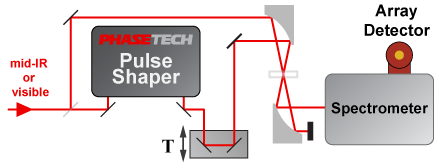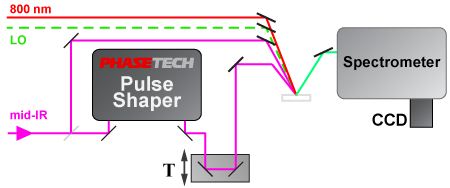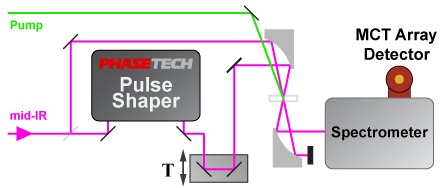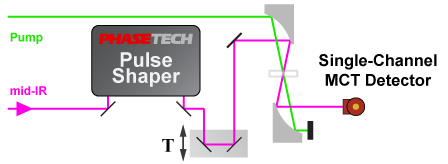
Applications of Pulse Shaping
There are many application of pulse shaping. Here are a few examples, along with schematics of experimental layouts.
Get more information about our pulse shapers at the products page. Call or email for quote.
Please contact us with questions about how to use pulse shaping in these and other experiments.

Pulse shaping is quickly becoming the preferred method of collecting 2D spectra.
The majority of the laser source is sent through a PhaseTech pulse shaper, which generates the pump pair. A smaller fraction of the laser is sent around the shaper and is used as the probe pulse. The probe pulse is detected with a spectrometer and an array detector.
The same basic setup can also be used for coherent control experiments. The shaper is used to generate arbitrarily shaped pulses which interact with the sample, while the probe pulse is used to detect the state of the system.
References
Two-Dimensional Electronic Spectroscopy Reveals Excitation Energy-Dependent State Mixing during Singlet Fission in a Terrylenediimide Dimer, Journal of the American Chemical Society (2018), 140, 17907 Residue-specific structural kinetics of proteins through the union of isotope labeling, mid-IR pulse shaping, and coherent 2D IR spectroscopy, Methods (2010), 50, 12-22 Controlling Vibrational Excitation with Shaped Mid-IR Pulses, Phys. Rev. Lett. (2007), 99, 038102 Mode selectivity with polarization shaping in the mid-IR, New J. Phys (2009), 11, 105046
Add a PhaseTech pulse shaper to your existing SFG or heterodyned SFG setup to measure 2D SFG spectra.
2D heterodyned SFG combine the surface selectivity and monolayer sensitivity of SFG with the enhanced spectral resolution and information content of 2D IR spectroscopy.
References
Short-Range Catalyst–Surface Interactions Revealed by Heterodyne Two-Dimensional Sum Frequency Generation Spectroscopy J. Phys. Chem. Lett. (2015), 6, 4204–4209 Adding a dimension to the infrared spectra of interfaces using heterodyne detected 2D sum-frequency generation (HD 2D SFG) spectroscopy Proc. Natl. Acad. Sci. USA (2011), 108, 20902-20907
Transient 2D spectroscopy is a power method for studying excited-state dynamics because it directly correlates ground- and excited-state marker bands as well as provides enhanced structural information through crosspeaks and 2D lineshapes.
Pulse shaping simplifies the experimental setup of transient 2D spectroscopy and improves signal-to-noise through fast delay scanning, phase cycling and the use of a rotating frame.
Email us to ask about adding a transient 2D option to our 2DQuick IR or 2DQuick Visible spectrometers.
References
Transient 2D IR Spectroscopy of Charge Injection in Dye-Sensitized Nanocrystalline Thin Films, J. Am. Chem. Soc. (2009), 131, 1520-1526
Here a PhaseTech pulse shaper is used to rapidly scan the time delay between the mid-IR and upconversion pulse. Shot-by-shot scanning provides improved signal-to-noise over traditional, optical delay lines. Pulse shaping also allows the use of other techniques which improves signal-to-noise, such as phase cycling and collecting the signal in a rotating frame.
A PhaseTech visible/near-IR pulse shaper can also be used on the upconversion pulse to allow for greater experimental flexibility in frequency-domain SFG.
References
A new approach to vibrational sum frequency generation spectroscopy using near infrared pulse shaping, Rev. Sci. Inst. (2019), 90, 033106 Time-Domain SFG Spectroscopy Using Mid-IR Pulse Shaping: Practical and Intrinsic Advantages, J. Phys. Chem. B (2011), 115, 2536-2546
Our PhaseTech pulse shaper can be used measure the spectrum of a mid-IR pulse via time- or frequency-domain scanning.
Eliminates the need for an expensive spectrometer and mid-IR array detector.
Provides nearly arbitrary tuning of spectral range and resolution, set through software.
